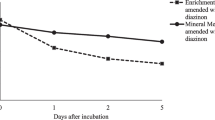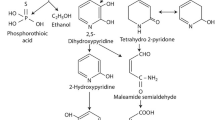Abstract
The pyrethroid insecticide cypermethrin is in extensive use since 1980s for insect control. However, its toxicity toward aquatic animals and humans requires its complete removal from contaminated areas that can be done using indigenous microbes through bioremediation. In this study, three bacterial strains isolated from agricultural soil and identified as Acinetobacter calcoaceticus MCm5, Brevibacillus parabrevis FCm9, and Sphingomonas sp. RCm6 were found highly efficient in degrading cypermethrin and other pyrethroids. These bacterial strains were able to degrade more than 85 % of cypermethrin (100 mg L−1) within 10 days. Degradation kinetics of cypermethrin (200 mg kg−1) in soils inoculated with isolates MCm5, FCm9, and RCm6 suggested time-dependent disappearance of cypermethrin with rate constants of 0.0406, 0.0722, and 0.0483 d−1 following first-order rate kinetics. Enzyme assays for Carboxylesterase, 3-PBA dioxygenase, Phenol hydroxylase, and Catechol-1,2 dioxygenase showed higher activities with cypermethrin treated cell-free extracts compared to non-treated cell-free extracts. Meanwhile, SDS-PAGE analysis showed upregulation of some bands in cypermethrin-treated cells. This might suggest that cypermethrin degradation in these strains involves inducible enzymes. Besides, the isolates displayed substantial plant growth-promoting traits such as phosphate solubilization, Indole acetic acid production, and ammonia production. Implying the efficient biodegradation potential along with multiple biological properties, these isolates can be valuable candidates for the development of bioremediation strategies.





Similar content being viewed by others
References
Bano N, Musarrat J (2003) Isolation and characterization of phorate degrading soil bacteria of environmental and agronomic significance. Lett Appl Microbiol 36:349–353
Bradford MM (1976) A rapid and sensitive method for the quantitation of microgram quantities of protein utilizing the principle of protein-dye binding. Anal Chem 72:248–254
Chen S, Hu M, Liu J, Zhong G, Yang L, Rizwan-ul-Haq M, Han H (2011) Biodegradation of beta-cypermethrin and 3-phenoxybenzoic acid by a novel Ochrobactrum lupini DG-S-01. J Hazard Mater 187:433–440. doi:10.1016/j.jhazmat.2011.01.049
Chen S, Lai K, Li Y, Hu M, Zhang Y, Zeng Y (2011) Biodegradation of deltamethrin and its hydrolysis product 3-phenoxybenzaldehyde by a newly isolated Streptomyces aureus strain HP-S-01. Appl Microbiol Biotechnol 90:1471–1483. doi:10.1007/s00253-011-3136-3
Chen S, Geng P, Xiao Y, Hu M (2012) Bioremediation of beta-cypermethrin and 3-phenoxybenzaldehyde contaminated soils using Streptomyces aureus HP-S-01. Appl Microbiol Biotechnol 94:505–515. doi:10.1007/s00253-011-3640-5
Chen S, Hu W, Xiao Y, Deng Y, Jia J, Hu M (2012) Degradation of 3-Phenoxybenzoic Acid by a Bacillus sp. PLoS ONE 7:e50456
Cunliffe M, Kertesz MA (2006) Effect of Sphingobium yanoikuyae B1 inoculation on bacterial community dynamics and polycyclic aromatic hydrocarbon degradation in aged and freshly PAH-contaminated soils. Environ Pollut 144:228–237. doi:10.1016/j.envpol.2005.12.026
Ehrt S, Schirmer F, Hillen W (1995) Genetic organization, nucleotide sequence and regulation of expression of genes encoding phenol hydroxylase and catechol 1,2-dioxygenase in Acinetobacter calcoaceticus NCIB8250. Mol Microbiol 18:13–20
Guo P, Wang B, Hang B, Li L, Ali SW, He J, Li S (2009) Pyrethroid-degrading Sphingobium sp. JZ-2 and the purification and characterization of a novel pyrethroid hydrolase. Int Biodeterior Biodegrad 63:1107–1112. doi:10.1016/j.ibiod.2009.09.008
Heuer H, Krsek M, Baker P, Smalla K, Wellington EM (1997) Analysis of actinomycete communities by specific amplification of genes encoding 16S rRNA and gel-electrophoretic separation in denaturing gradients. Appl Environ Microbiol 63:3233–3241
Hintzen EP, Lydy MJ, Belden JB (2009) Occurrence and potential toxicity of pyrethroids and other insecticides in bed sediments of urban streams in central Texas. Environ Pollut 157:110–116
Karpouzas DG, Fotopoulou A, Spiroudi MU, Singh BK (2005) Non-specific biodegradation of the organophosphorus pesticides, cadusafos and ethoprophos, by two bacterial isolates. FEMS Microbiol Ecol 53:369–378. doi:10.1016/j.femsec.2005.01.012
Kirchner U, Westphal AH, Müller R, van Berkel WJ (2003) Phenol hydroxylase from Bacillus thermoglucosidasius A7, a two-protein component monooxygenase with a dual role for FAD. J Biol Chem 278:47545–47553
Lan WS, Gu JD, Zhang JL, Shen BC, Jiang H, Mulchandani A, Chen W, Qiao CL (2006) Coexpression of two detoxifying pesticide-degrading enzymes in a genetically engineered bacterium. Int Biodeterior Biodegrad 58:70–76. doi:10.1016/j.ibiod.2006.07.008
Li X, He J, Li S (2007) Isolation of a chlorpyrifos-degrading bacterium, Sphingomonas sp. strain Dsp-2, and cloning of the mpd gene. Res Microbiol 158:143–149. doi:10.1016/j.resmic.2006.11.007
Lin Q, Chen S, Hu M, Rizwan-ul-Haq M, Yang L, Li H (2011) Biodegradation of cypermethrin by a newly isolated actinomycetes HU-S-01 from wastewater sludge. Int J Environ Sci Tech 8:45–56
Liu F, Hong M, Liu D, Li Y, Shou P, Yan H, Shi G (2007) Biodegradation of methyl parathion by Acinetobacter radioresistens USTB-04. J Environ Sci 19:1257–1260. doi:10.1016/s1001-0742(07)60205-8
Madhaiyan M, Poonguzhali S, Hari K, Saravanan V, Sa T (2006) Influence of pesticides on the growth rate and plant-growth promoting traits of Gluconacetobacter diazotrophicus. Pest Biochem Physiol 84:143–154
Maloney S, Maule A, Smith AR (1993) Purification and preliminary characterization of permethrinase from a pyrethroid-transforming strain of Bacillus cereus. Appl Environ Microbiol 59:2007–2013
Meeker JD, Barr DB, Hauser R (2009) Pyrethroid insecticide metabolites are associated with serum hormone levels in adult men. Reprod Toxicol 27:155–160
Nieradko Iwanicka B, Borzêcki A (2008) Effect of cypermethrin on memory, movement activity and co-ordination in mice after transient incomplete cerebral ischemia. Pharmacol Reports 60:699
Rajkumar M, Nagendran R, Lee KJ, Lee WH, Kim SZ (2006) Influence of plant growth promoting bacteria and Cr 6+ on the growth of Indian mustard. Chemosphere 62:741–748
Reddy MS, Naresh B, Leela T, Prashanthi M, Madhusudhan NC, Dhanasri G, Devi P (2010) Biodegradation of phenanthrene with biosurfactant production by a new strain of Brevibacillus sp. Bioresour Technol 101:7980–7983
Singh B, Kaur J, Singh K (2012) Biodegradation of malathion by Brevibacillus sp. strain KB2 and Bacillus cereus strain PU. World J Microbiol Biotechnol 28:1133–1141. doi:10.1007/s11274-011-0916-y
Sogorb MA, Vilanova E (2002) Enzymes involved in the detoxification of organophosphorus, carbamate and pyrethroid insecticides through hydrolysis. Toxicol Lett 128:215–228. doi:10.1016/S0378-4274(01)00543-4
Tallur PN, Megadi VB, Ninnekar HZ (2008) Biodegradation of cypermethrin by Micrococcus sp. strain CPN 1. Biodegradation 19:77–82. doi:10.1007/s10532-007-9116-8
Tamura K, Peterson D, Peterson N, Stecher G, Nei M, Kumar S (2011) MEGA5: molecular evolutionary genetics analysis using maximum likelihood, evolutionary distance, and maximum parsimony methods. Mol Biol Evol 28:2731–2739
Tsai SC, Tsai LD, Li YK (2005) An isolated Candida albicans TL3 capable of degrading phenol at large concentration. Biosci Biotechnol Biochem 69:2358–2367
Wani PA, Khan MS, Zaidi A (2007) Chromium reduction, plant growth-promoting potentials, and metal solubilizatrion by Bacillus sp. isolated from alluvial soil. Curr Microbiol 54:237–243
Weston D, Holmes R, Lydy M (2009) Residential runoff as a source of pyrethroid pesticides to urban creeks. Environ Pollut 157:287–294
Zhai Y, Li K, Song J, Shi Y, Yan Y (2012) Molecular cloning, purification and biochemical characterization of a novel pyrethroid-hydrolyzing carboxylesterase gene from Ochrobactrum anthropi YZ-1. J Hazard Mater 221–222:206–212. doi:10.1016/j.jhazmat.2012.04.031
Zhang C, Jia L, Wang S, Qu J, Li K, Xu L, Shi Y, Yan Y (2010) Biodegradation of beta-cypermethrin by two Serratia spp. with different cell surface hydrophobicity. Bioresour Technol 101:3423–3429. doi:10.1016/j.biortech.2009.12.083
Acknowledgments
The financial support for the PhD work was provided by Higher Education Commission (HEC), Islamabad, Pakistan through Indigenous scholarship for work in Pakistan and International Research Support Initiative Program (IRSIP) funds to visit the Faculty of agriculture and Environment, University of Sydney.
Author information
Authors and Affiliations
Corresponding author
Rights and permissions
About this article
Cite this article
Akbar, S., Sultan, S. & Kertesz, M. Determination of Cypermethrin Degradation Potential of Soil Bacteria Along with Plant Growth-Promoting Characteristics. Curr Microbiol 70, 75–84 (2015). https://doi.org/10.1007/s00284-014-0684-7
Received:
Accepted:
Published:
Issue Date:
DOI: https://doi.org/10.1007/s00284-014-0684-7




